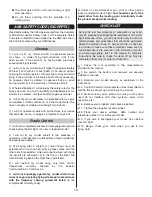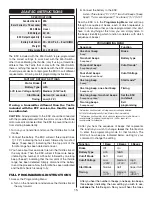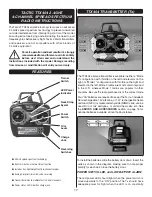
16
(“ 1 2 1 2”) indicating that the value has been set and
saved. If you immediately lower the throttle stick (within
two seconds) you will exit programming mode proceeded
by the three short beeps (“beep beep beep”) counting the
number of LiPo cells, followed by one long beep (“beeep”)
indicating that the model is ready to fl y. Or, you can simply
disconnect the battery at any time to exit programming
mode.
If you leave the stick advanced, the programming mode will
resume where it left off—simply listen for the sequence of
beeps that represents the next function you wish to change,
then lower the throttle stick again to enter the programming
mode for that function.
Example
To set the motor brake from the factory default of “off” to “on”:
1. Advance the throttle stick. Turn on the transmitter.
2. Connect the battery. Listen for the three tones (“ 1 2 3”)
followed by two short beeps (“beep beep”) followed by a
5-second pause followed by fi ve tones (“ 1 2 3 4 5”). The
ESC is now in the Programming Menu.
3. After you hear one short beep (“beep”) indicating the
motor brake function, lower the throttle stick.
4. Listen for the beeps: one beep = brake off, two beeps
= brake on. If you do nothing the ESC will simply loop
through the sequence of beeps—once, then twice, then
once, then twice, etc. waiting for your command to turn the
brake on or off. To turn the brake on, advance the throttle
stick after the two beeps. Listen for the tones (“ 1 2 1 2”)
indicating that the setting has been set and saved. If that’s
all you wanted to set, immediately lower the throttle stick
(within two seconds) to exit programming mode, then hear
three short beeps (“beep beep beep”) followed by one
long beep (“beeep”) indicating that the model is ready to
fl y.
Auto-Protection
The ESC features Auto-Protection to discontinue power to
the motor under certain conditions:
1.
Start up failure:
If the motor fails to start within 2 seconds
of advancing the throttle the ESC will automatically cut
power. To restart, lower the throttle stick, then advance
again. This can happen if there is a poor connection
between the ESC and motor or if the propeller or motor is
impeded for any reason.
2.
Over-heat protection:
If the ESC temperature ever rises
to about 110 Celsius
the ESC will automatically reduce
power.
3.
Signal loss:
Power to the motor will be reduced if the
throttle signal is lost for 1 second. If the signal is lost for 2
seconds motor power will be cut completely.
Problem
Reason
Action
Swap any two of the motor/ESC wire connections with
each other.
The three motor wires are
incorrectly connected to the ESC.
The motor turns the wrong
direction.
Problem
Reason
Action
Set the throttle direction the other way in the transmitter.
The direction of the throttle channel
is reversed and the ESC has entered
the Programming Menu.
Problem
Reason
Action
Lower the throttle stick all the way, or recalibrate the
throttle per calibration instructions.
Throttle stick is not in the lowest
position, or throttle needs to be
calibrated.
Motor does not work, Alert Tone
sounds (rapid beeps:
“beepbeepbeepbeepbeep…).
Problem
Reason
Action
Check the battery or plugs or change the plugs if the
wires are damaged.
The ESC is not receiving power
from the battery.
Motor does not work, no tones or
beeps are coming from the ESC.
Motor does not work, five tones
are sounded (“ 1 2 3 4 5”)
after the two beeps.
TROUBLESHOOTING GUIDE
Problem
Reason
Action
Make sure the transmitter is turned on and that the
receiver is linked to the transmitter and receiving a signal.
The ESC is receiving power from
the battery, but is not receiving a
signal from the receiver.
Motor does not work, Alert Tone
sounds (long beeps: “beeeep-
beeeep-beeeep…).
Problem
Reason
Action
Make sure the battery is charged and/or you are using
the correct battery.
Battery Voltage is too
high or too low.
Motor does not work, Alert Tone sounds
(“beep-beep,” “beep-beep,” “beep-beep,”…).









































